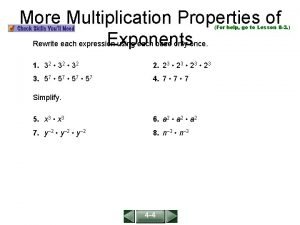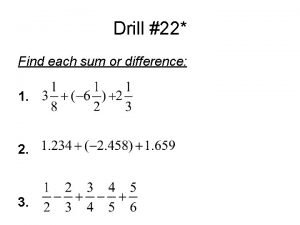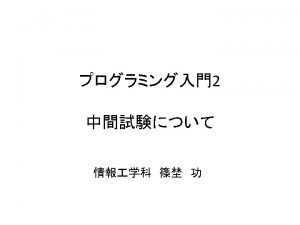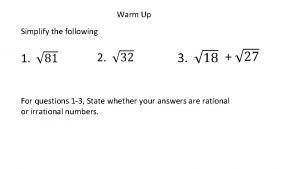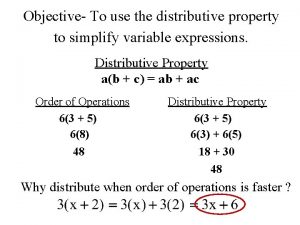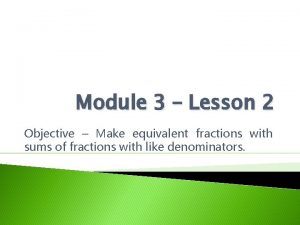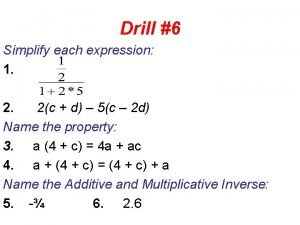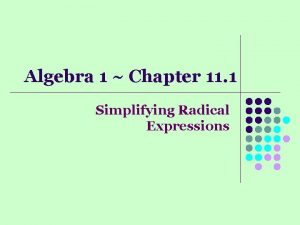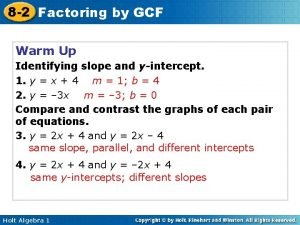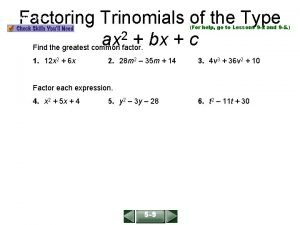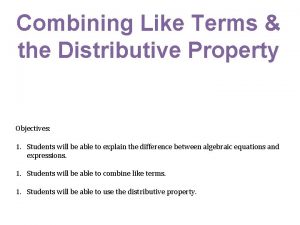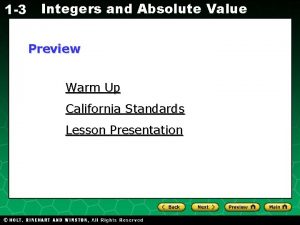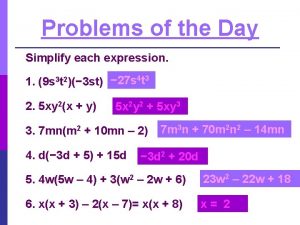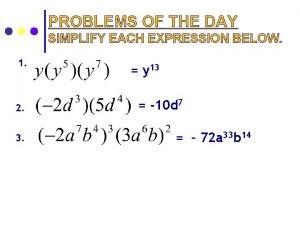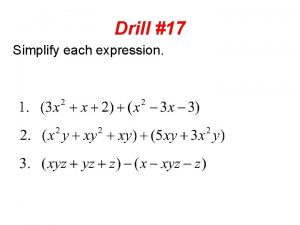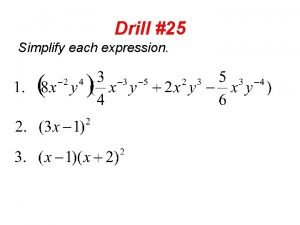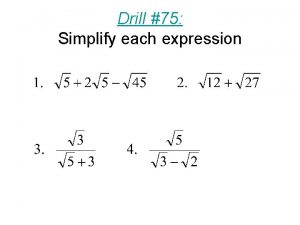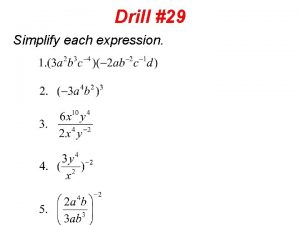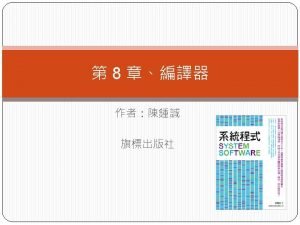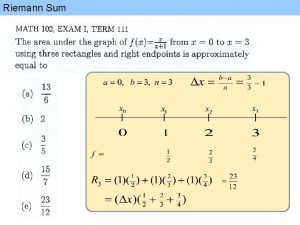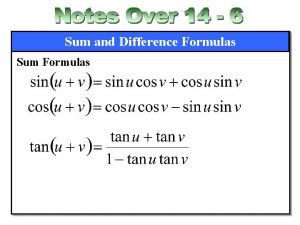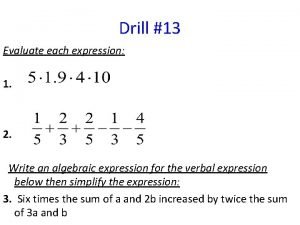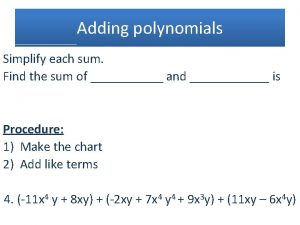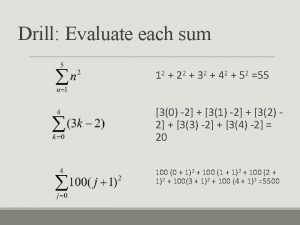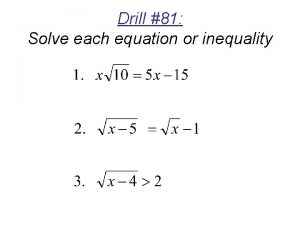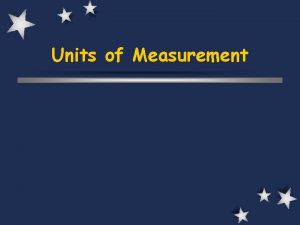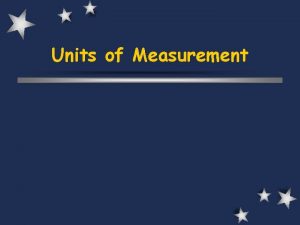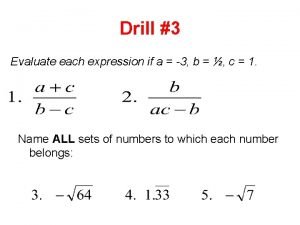Drill Write each expression as a sum of


















- Slides: 18

Drill: Write each expression as a sum of powers of x. (No variables in the denominator!)

Lesson 3. 3: Derivatives Day #1 Homework page 124: 1 -13, 15 -22 (do not show graphically)

Derivative of a Constant Function n If is the function with the constant value c, then df/dx = d/dx (c) = 0 n Example: y = 4, find dy/dx n dy/dx= 0

Power Rule for Positive Integer Powers of x n If n is a positive integer, then d/dx (xn) = nxn-1 n Examples: n y = x 3 n dy/dx= 3 x 2 n y = 4 x 4 n dy/dx = 16 x 3

The Sum and Difference Rule n If u and v are differentiable functions of x, then their sum and differences are differentiable at every point where u and v are differentiable: n d/dx ( u ± v) = du/dx ± dv/dx n Example: n y = x 3 + ½ x 2 – 3 x + 2 n dy/dx= 3 x 2 + x - 3

Finding Horizontal Tangents n Does the curve y = x 4 – 2 x 2 + 2 have any horizontal tangents? If so, where? n Calculate dy/dx n 4 x 3 – 4 x n Solve the equation dy/dx = 0 for x. n 4 x 3 – 4 x = 0 n 4 x (x 2 – 1) = 0 n 4 x (x – 1) (x + 1) = 0 n 4 x = 0; (x – 1) = 0; (x + 1) = 0 n x = 0, 1, -1

The Product Rule n d/dx (uv) = u (dv/dx) + v(du/dx) n Find f’(x) if f(x) = (x 2 + 1) (x 3 + 3) n Let u = x 2 + 1 and v = x 3 + 3 n dv/dx = 3 x 2 and du/dx = 2 x n u (dv/dx) + v(du/dx) = (x 2 + 1 )(3 x 2) + (x 3 + 3)(2 x) n 3 x 4 + 3 x 2 + 2 x 4 + 6 x n 5 x 4 + 3 x 2 + 6 x

The Quotient Rule

Drill: Find the derivative of each of the following functions. 6 4 2 x – 5 x + 2 x 3 (x + x) 2 (2 x + 3)

How to support derivatives graphically n Let y 1 = f’(x) and y 2 = NDER f(x). They should coincide.

Working with Numerical Values n Let y = uv be the product of the functions u and v. Find y’(2) if n u(2) = 3, u’(2) = -4, v(2) = 1 and v’(2) = 2 n So, from the product rule: n u(2)v’(2) + v(2)u’(2) n 3(2) + 1(-4) = 2

Negative Integer Powers of x n If n is a negative integer and x ≠ 0, then n d/dx (xn) = nxn-1 n Example: f(x) = -2 x-3 n f’(x) = 6 x-4

Using the Power Rule n Find an equation for the line tangent to the curve y = (x 2 + 3)/2 x at the point (1, 2) n While we could find the derivative by the Quotient Rule, but it is easier to first simplify into a sum of two powers: (x 2/2 x) + 3/2 x = ( ½ ) x + (3/2)x-1 n dy/dx = ½ - (3/2)x-2 n The slope at x = 1: n ½ - (3/2) (1)-2 = ½ - 3/2 = -1 n Using the slope of -1 and the point (1, 2): n y – 2 = -1 (x – 1 ) y = -1 x + 3

Second and High Order Derivatives n dy/dx: first derivative n f’(x) = y’ n dy’/dx = second derivative n f’’(x) = y’’ = d 2 y/dx 2 n dy’’/dx = third derivative n f’’’(x) = y’’’ = d 3 y/dx 3 n etc….

Find the first four derivatives of y =x 3 – 5 x 2 + 2 n y’: 3 x 2 – 10 x n y’’ = 6 x – 10 n y’’’ = 6 n y’’’’= 0

Finding Instantaneous Rates of Change n (page 123, example 5) n An orange farmer currently has 200 trees yielding an average of 15 bushels of oranges per tree. She is expanding her farm at the rate of 15 trees per year, while improved husbandry is improving her average annual yield by 1. 2 bushels by tree. What is the current (instantaneous) rate of increase of her total annual production of oranges?

Solution n Let t(x) = the number of trees x years from now n Let y(x) = yield per tree x years from now n p(x) = t(x)y(x) is the total production of oranges in year x. n We know t(0) = 200; y (0) = 15; t’(0) = 15; y’(0) = 1. 2 n We need to find p’(x), so we can use the product rule: n t(0)y’(0) + y(0)t’(0) n 200(1. 2) + 15(15) = 465 bushels per year.

Homework n page 124 -125: 23 -37, 51
 7-3 practice more multiplication properties of exponents
7-3 practice more multiplication properties of exponents Sum up drill
Sum up drill Sum0
Sum0 Quadratic formula examples
Quadratic formula examples For questions 1–2, simplify each expression.
For questions 1–2, simplify each expression. Factor each expression
Factor each expression Choose the correct particle back away
Choose the correct particle back away Rewrite 5m-10m using distributive property
Rewrite 5m-10m using distributive property Show each expression on a number line
Show each expression on a number line Substitution property of equality
Substitution property of equality Simplify each radical expression
Simplify each radical expression Factor the expression examples
Factor the expression examples Factoring trinomials of the type ax2+bx+c
Factoring trinomials of the type ax2+bx+c Factorization cases
Factorization cases Using distributive property and combining like terms
Using distributive property and combining like terms Evaluate each expression integers
Evaluate each expression integers Simplify each expression
Simplify each expression Simplify each expression by combining like terms
Simplify each expression by combining like terms Simplify the expression below
Simplify the expression below
